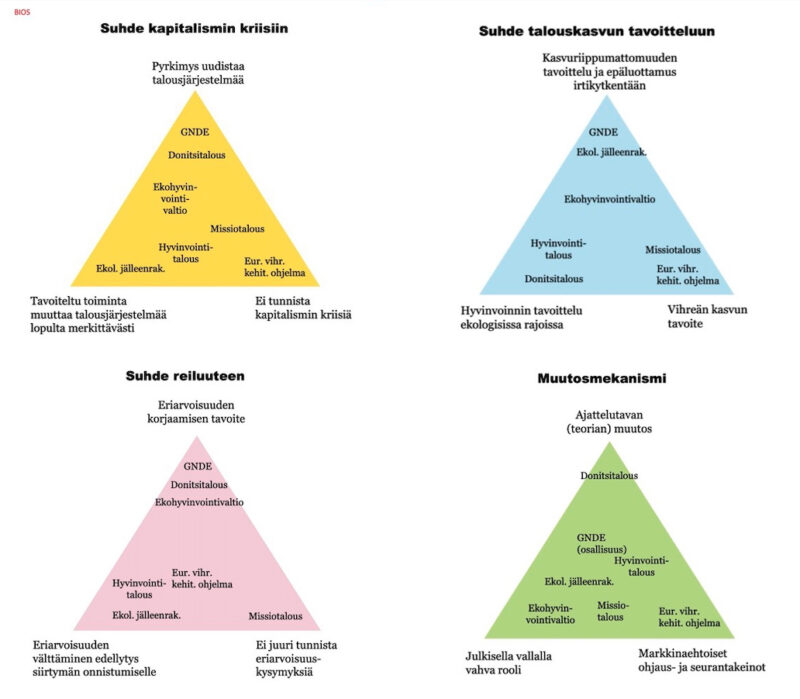Annoimme 19. lokakuuta pyynnöstä lausunnon eduskunnan talousvaliokunnalle.
Asiat: VNS 4/2022 vp Valtioneuvoston selonteko Keskipitkän aikavälin ilmastopolitiikan suunnitelma
Kohti hiilineutraalia yhteiskuntaa 2035 https://www.eduskunta.fi/pdf/VNS+4/2022
VNS 6/2022 vp Valtioneuvoston selonteko Hiilineutraali Suomi 2035 – kansallinen ilmasto- ja energiastrategia https://www.eduskunta.fi/pdf/VNS+6/2022
VNS 7/2022 vp Valtioneuvoston selonteko maankäyttösektorin ilmastosuunnitelmasta https://www.eduskunta.fi/pdf/VNS+7/2022
Lausunnon pääsanomat:
- Suunnitelmista ja strategiasta puuttuu riittävä kokonaisvaltaisuus ja ennakoivuus: hiilineutraaliustavoitteen saavuttaminen on jätetty suotuisien tapahtumaketjujen varaan (erityisesti taakanjakosektorilla ja suhteessa nieluihin). Tätä vastoin riittäviin päästövähennyksiin on oltava suunnitelmat, jotka johtavat hiilineutraalisuuteen joka tapauksessa (ennakoitavuuden rajoissa).
- Päästötavoitteet ovat kiitettävät, mutta keinot selvästi riittämättömät ja epävarmat.
- Suunnitelmissa on rakenteellinen ongelma: ne nojaavat epärealistiseen ennusteeseen nielujen kasvusta, mikä johtaa myös taakanjakosektorin toimien alimittaisuuteen.
- Alimitoituksen korjaamiseksi tarvitaan huomattavasti enemmän päästövähennyksiä, eikä harkittavaksi jätettyjä toimia (esim. liikenteen päästökauppaa) tule enää empiä vaan saattaa toimeen.
- Eläintuotannon vähentäminen on toistuvasti todettu tärkeäksi keinoksi maatalouden päästöjen vähentämiseen; tämä ei valitettavasti näy maataloussektoria ja kulutusta koskevissa suunnitelmissa.
Kiitämme mahdollisuudesta lausua eduskunnan talousvaliokunnalle valtioneuvoston selonteoista keskipitkän aikavälin ilmastopolitiikan suunnitelmasta (KAISU), kansallisesta ilmasto- ja energiastrategiasta sekä maankäyttösektorin ilmastosuunnitelmasta (MISU).
Käsillä oleva suunnitelmien ja strategioiden kolmikko (jatkossa: suunnitelmat) on mitä tärkein kokonaisuus, sillä niiden avulla ohjataan suomalaista ilmastopolitiikkaa lähivuodet. Olemme ilmastonmuutoksen hillinnän historiallisessa käännekohdassa: joko nopea ja johdonmukainen päästöjen vähennys saadaan niin Euroopassa kuin globaalistikin käyntiin nyt, tai ilmastonmuutoksen niin sanotuissa turvarajoissa pysymiselle ei ole enää mahdollisuuksia. Epäonnistuminen tarkoittaisi mittaamattoman suuria negatiivisia ekologisia, sosiaalisia ja taloudellisia seurauksia. Odotteluun ei ole aikaa. Nyt on laadittava suunnitelmia, joilla ilmastotavoitteet saavutetaan.
On kiitettävää, että suunnitelmissa tavoitteeksi asetetaan Euroopan unionin päästötavoitteet. Lähivuosina ja -vuosikymmeninä ei ole nähtävissä muuta kehityssuuntaa kuin yhä kiristyvät ilmastotavoitteet. Tätä ajavat ilmastonmuutoksen negatiivisten seurauksien toteutuminen kautta linjan ennakoitua nopeammassa aikataulussa ja akuutti energiakriisi, jonka Venäjän hyökkäys Ukrainaan laukaisi. Irtaantuminen fossiilisista polttoaineista on välttämätöntä niin nopean kuin hitaankin kriisin torjumiseksi.
Suunnitelmia kuitenkin vaivaa kokonaisvaltaisuuden puute ja epävarmuutta aiheuttava ehdollisuus. Toistaiseksi päästövähennysten leijonanosasta on vastannut päästökauppasektorin energiantuotanto. Taakanjakosektorilla päästöt ovat vähentyneet pienesti tai eivät lainkaan. Näin nettonollatavoite on jäänyt hiilinielujen kasvun varaan. Yhdellä kortilla pelaaminen ei kuitenkaan ole vastuullista ilmastopolitiikkaa. Nieluihin keskittymisen sijaan suunnitelmat on laadittava niin, että nettonollaan päästään joka tapauksessa, riippumatta esimerkiksi juuri maankäyttösektorin hiilitaseen kehityksestä. Tämä vaatii ennakointia ja järjestelmällistä varautumista myös epäsuotuisiin kehityskulkuihin. Käytännössä tarvitaan sektori- ja hallinnonrajat ylittäviä toimia, jotka muuttavat tuotannon ja kulutuksen rakenteita. Muuten jokin päästölähde tai nielu saattaa joutua kohtuuttoman suurten ja nopeiden toimien kohteeksi. Nyt suunnitelmat pelaavat tällaista häviävää korttia joko taakanjakosektorille tai maankäyttösektorille.
Ilmastolain edellyttämä hiilinegatiivisuus on suunnitelmissa aivan oikein pitkän aikavälin tavoite. Myös tässä kokonaisvaltaisuus ja ennakointi korostuu. Nettonegatiivisuuden saavuttaminen edellyttää ongelmallisten polkuriippuvuuksien välttämistä. Toisin sanoen tähdättäessä nettonollaan ei voida rakentaa tuotantoa ja kulutusta, joka jatkossa toimii esteenä etenkin hiilinielujen vahvistamiselle ja siten pyrkimiselle kohti nettonegatiivista tilannetta. Valitettavasti virheellisiä polkuriippuvuuksia on suunnitelmissa idulla; palaamme näihin tuonnempana.
Pelkkä tavoitteiden oikea mitoitus ei riitä: on oltava uskottavia polkuja niiden toteuttamiseen. Tarvitaan sekä merkittäviä päästövähennyksiä kaikilla sektoreilla että nielujen vahvistamista. Nielut ovat ennen kaikkea tapa toteuttaa tulevaa nettonegatiivisuutta, eikä niihin tule suhtautua ensisijaisesti muualla tapahtuvien päästöjen kuittaajana, kuten valitettavasti nyt on laita. Keskipitkän aikavälin ilmastopolitiikan suunnitelma toteaa: “Jos halutaan varmistua ilmastotavoitteiden saavuttamisesta, tulisi päästöjä vähentävien toimien kokonaisuus lähtökohtaisesti ylimitoittaa.” (163) Näin ei nyt ole, vaan suunnitelmien lopputulos on alimitoitettu.
Käsiteltäviä suunnitelmia laaditaan voimassa olevan ilmastolain oloissa, ja uutta ilmastolakia laaditaan parhaillaan. Lausunnossaan sitä koskien BIOS peräänkuulutti kokonaisvaltaisempaa suunnittelun järjestelmää, jossa päästövähennykset ja hiilinielujen vahvistaminen muodostavat johdomukaisen kokonaisuuden. Tällainen pyrkimys tarvitaan jo nykyisen lain piirissä tehtäviin suunnitelmiin. Monet ilmastopolitiikkaan vaikuttavat prosessit Euroopan unionissa ovat kesken. Epävarmuus ei kuitenkaan ole peruste päästövähennysten puutteelle. Päinvastoin: sääntelyn ja suunnitelmien tulee ennakoida EU:n ilmastopolitiikan jatkuvaa tiukentumista ja hahmottaa, että ilmastotavoitteiden saavuttaminen vaatii systeemitason muutosta yhteiskunnassa.
Ongelma: nojaaminen nielujen kasvuun
Suunnitelmiin sisältyvä reitti hiilineutraalisuuteen nojaa päästövähennysten lisäksi kasvaviin hiilinieluihin. Kuten yllä todettu, tämä rakenne on jo itsessään ongelmallinen, aiheuttaen päästövähennysten alimitoitusta ja toimien ennakoimattomuutta. Lisäksi suunnitelmien oletukset nielujen kehittymisestä ovat ylioptimistisia. Tästä juontuvat ongelmat heijastuvat lukuisin tavoin yksittäisiin toimenpiteisiin ja niiden mittakaavaan varsinkin taakanjakosektorilla.
Suunnitelmia ei ole suhteutettu nykytilanteeseen, jossa maankäyttösektori on todettu vähintään väliaikaisesti päästölähteeksi. Seikka mainitaan ohimennen (MISU 13, Ilmasto- ja energiastrategia 87), mutta se ei ole vaikuttanut toimenpidesuunnitelmiin. Jos jo aiemmin oli jo syytä varautua tilanteeseen, jossa metsän kasvu ei kiihdy metsäsektorin omien skenaarioiden mukaisesti, nyt viimeistään on havahduttava myös mahdollisuuteen, että metsän kasvu voi jopa hidastua.
Tätä vastoin suunnitelmissa nojataan oletukseen, että maankäyttösektorin nielut saadaan kasvamaan voimakkaasti. Tämän kasvun varassa ja mm. kustannustehokkuuden nimissä pyritään välttämään päästöleikkauksia etenkin taakanjakosektorilla, käyttämällä maankäyttösektorin joustoa – tämä on jopa yksi kansallisen ilmasto- ja energiastrategian päälinjauksia (11). Toisin sanoen taakanjakosektorin toimia alimitoitetaan tietoisesti sillä oletuksella, että tarvittavia joustoja saadaan maankäyttösektorilta (KAISU 159). Puhe “kustannustehokkuudesta” on kuitenkin tyhjää, jos ilmastotavoitteita ei ole mahdollista saavuttaa tällä tavalla. BIOS yhtyykin siksi KAISUn edellisellä lausuntokierrokselle esitettyihin näkemyksiin: “Lausunnoissa esitettiin, että jo tunnistettuja lisätoimia vietäisiin toteutukseen sen sijaan, että puuttuvat päästövähennykset hankitaan joustoilla.” (KAISU 177)
Joka tapauksessa hiilinielujen kokoon ja kasvattamiseen liittyy huomattavia epävarmuuksia (ääreytyvät säätilat, muuttuvan ilmaston aiheuttamat tuholaisongelmat, geopoliittiset uhkat, jne.). Ilmastostrategian rakentaminen tällaisten epävarmuuksien päälle ilman vankkaa vaihtoehtoista suunnitelmaa on valmistautumista epäonnistumiseen. Riittäviin päästövähennyksiin on oltava suunnitelma, joka saavuttaa ilmastotavoitteet joka tapauksessa (tietysti ennakoitavuuden rajoissa). Tällainen suunnitelma voi ottaa joustavasti huomioon nielujen tulevan kehityksen oli se sitten kasvava tai laskeva.
Mitä nielujen kehittymiseen itseensä tulee, MISUssa todetaan, että suurin metsien hiilitaseeseen vaikuttava seikka on metsien hakkuutaso, mihin puolestaan eniten vaikuttaa markkinatilanne eli puun kysyntä (56). Kun tämä tilanne on hyvin tiedossa ja kun sektori tällä hetkellä on päästölähde, tulisi suunnitelmien jo nyt sisältää riittävät kuvaukset ja arviot keinoista, joilla hakkuumääriin voidaan vaikuttaa. Kansalliseen metsästrategian luonnokseen (KMS2035) sisältyvä kuvaus kansallisesta strategiauniversumista (s.15) kertoo, että metsien käyttöön vaikuttaa Suomessa noin nelisenkymmentä erilaista eri alojen ja sektorien strategiaa, tiekarttaa ja ohjelmaa. Puukauppa tapahtuu markkinoilla ja markkinat on vahvasti muotoiltu sääntelyllä ja strategioilla. Tavoitetta hiilinieluja kasvattavasta puunkäytöstä ei voida jättää markkinamekanismin heilahtelujen varaan, vaan keinot markkinoiden uudelleenmuotoilemiseen on valmisteltava välittömästi.
On huomattava, että ongelmallinen oletus maankäyttösektorin nielujen koosta ja kasvusta koskee niin perusskenaarioita (WEM) kuin politiikkaskenaarioita (WAM). Perusskenaarioihin on “leivottu sisään” maankäyttösektorin nieluja koskevia oletuksia, jotka voivat osoittautua virheellisiksi. Näin käydessä myös suunnitellut politiikkaskenaarioiden lisätoimet jäävät lähtökohtaisesti alimitoitetuiksi. Toisin ilmaistuna: koko vuosille 2030 ja 2035 laskettu päästökuilu määrittyy hyvin todennäköisesti pohjalta, joka osoittautuu vielä virheelliseksi. Tähän tulisi reagoida jo ennakoiden.
Tämä riski on niin suuri ja niin todennäköinen, että päästöleikkaustoimia olisi ehdottomasti lisättävä kaikilla sektoreilla nykyisiin suunnitelmiin nähden. Asiaan on huomattavasti vaikeampaa, työläämpää ja kalliimpaa reagoida jälkijunassa, jos maankäyttösektorin ennakoitua pienemmät nielut (tai jopa sektorin pidempiaikainen muuttuminen päästölähteeksi) johtavat mittavien lisätoimien tarpeeseen taakanjakosektorilla ja päästökaupassa.
Riskiä lisää, että selonteon mukaan kansallisessa ilmasto- ja energiastrategiassa valmistaudutaan mittaviin infrastruktuuritoimiin metsäpuun energiakäytön lisäämiseksi (29–30), ja metsähakkeen energiakäytön oletetaan tuplaantuvan 2035 mennessä (86). Tällaisten suunnitelmien yhdistäminen oletukseen maankäyttösektorin nielun voimakkaasta kasvusta kertoo kokonaisvaltaisuuden puutteesta. Puun energiakäytön lisäämisen ja nielujen kasvattamisen välillä on ilmeinen vastakkaisuus riippumatta siitä, miten puun polton päästöjä raportoinnissa kohdellaan.
Uhkarohkeaa suhtautumista kuvaa myös MISUn toteamus: “Biomassojen käytön kestävyys ja käytettävyys ovat kestävän biotalouden edellytyksiä. Vaikutukset maankäyttösektorin tavoitteisiin ovat välillisiä, sillä strategiassa ei oteta kantaa käytettävissä olevan biomassan määrään.“ (35) Biomassojen käyttömäärä vaikuttaa ratkaisevasti sekä ilmastotavoitteisiin että luonnon monimuotoisuuden kehitykseen. Kantaa on siis otettava, jotta kestävän metsätalouden tulevaisuudennäkymät ovat selkeät ja ennakoitavissa. Oireellisesti vastaava kokonaisarvion puute luonnehtii myös muuten ansiokkaita toimialakohtaisia vähähiilitiekarttoja, joiden yhteelaskettu biomassan tarve ylittää rutkasti saatavilla olevan kotimaisen biomassan määrän.
Selonteossa KAISUsta todetaan: “On myös mahdollista, että koko tavoitekehikko rakennetaan uudestaan tulevien 15 vuoden aikana, mikäli todetaan, että nykyiset tavoitteet eivät riitä torjumaan ilmaston lämpenemistä riittävästi.” (164) Tämä on enemmän kuin todennäköistä, eikä 15 vuoden odotteluun ole aikaa. Jokainen viivytelty tai harhaan toimittu vuosi tarkoittaa, että tulevat toimet ovat kalliimpia, vaikeampia ja että turvarajoja ylitetään. Selonteon sivulla 87 todetaan: “Maakäyttösektorin skenaariot tullaan päivittämään yhdessä kansallisen ilmasto- ja energiaskenaarioiden päivityksen kanssa osana valtioneuvoston vuoden 2023 selvitys- ja tutkimustoimintaa.” Koska on ilmeistä, että suunnitelmien oletukset maankäyttösektorista eivät päde, miksi tehdä suunnitelmista jo lähtökohtaisesti vanhentuneita? Asiaan on syytä reagoida etupainotteisesti lisäämällä päästöleikkauksia jo nyt, ei vasta selvitysten jälkeen.
Suunnitelmissa ovat vaarassa toteutua juuri ne nettonolla-fokuksen riskit ja ongelmat, joista lukuisat tutkijat ja tutkimuslaitokset ovat pitkään varoittaneet, BIOS mukaan lukien. Ilmastonmuutoksen hillinnälle merkityksellinen asia on, kuinka paljon kasvihuonekaasuja kertyy ilmakehään vuosittain. Tilanne pahenee niin kauan kuin kertymä on positiivinen. Kun nettonollalaskelmista tulee päämäärä itsessään, seuraa juuri kuvatunlaista nojaamista epärealistisiin nieluoletuksiin, jotta vaikeampia päästöleikkauksia voitaisiin välttää. Tällöin noudatetaan ilmastopolitiikan ja – sopimusten kirjainta, ei niiden henkeä.
Liikenne
Toinen merkittävä ongelma kytkeytyy osittain maankäyttösektorin nieluihin liittyviin oletuksiin, joihin ajatus biopolttoaineiden ilmastohyödyistä perustuu. Kuten käsillä olevissa suunnitelmissa todetaan, biopolttoaineita on olemassa monenlaisia, ja vahvasti ympäristökestävien polttoaineiden kehitystyö on tärkeää. Mahdolliset tulevat vaihtoehtoiset polttoaineet ovat kuitenkin oma kysymyksensä – nykyisissä suunnitelmissa ja perusskenaarioissa nojataan pitkälti vanhan sukupolven biopolttoaineisiin, joiden ongelmista on esitetty laajaa tieteellistä kritiikkiä.
Taakanjakosektorilla jo perusskenaariossa (WEM) nojataan liikenteen suhteen siihen, että suuri määrä tarvittavia vähennyksiä saadaan aikaan jakeluvelvoitteella. Tämän oletuksen varaan rakentuu myös KAISUssa määriteltyjen lisätoimien volyymi – ja jälleen lisätoimissa biopolttoaineilla on suuri rooli. Biopolttoaineiden ilmastohyötyjä on kuitenkin kyseenalaistettu tutkimuksessa laajalti, etenkin kun niiden käytön volyymi on suuri ja kasvaa.
Nojaamalla yhä voimakkaammin biopolttoaineisiin luodaan juuri sellaista polkuriippuvuutta, joka vaarantaa ilmastotavoitteita. Liikenteen osalta toimien perusrunkona toimii fossiilittoman liikenteen tiekartta, josta BIOS lausui kriittisiä huomioita vuonna 2021: “Liikenteen ennakoinnin tulisi perustua siihen, että käytetään vain varmuudella päästövähennyksiä tuottavia biomassajakeita. Koska jakeluvelvoite on laskettu mukaan päästövähennysten perusennusteeseen ja lisätoimien ytimessä on jakeluvelvoitteen kasvattaminen, riskien toteutumisen aiheuttamat kielteiset vaikutukset päästövähennyspolulle ovat suuret.”
Liikenteen osalta BIOS kiittää, että keskipitkän aikavälin ilmastosuunnitelmassa korostuu mm. ajosuoritteiden väheneminen ja liikenteen systeeminen muutos, mutta näitä koskevat keinot ovat alimitoitettuja – siitä syystä, että tähtäimessä oleva päästökuilu on mitoitettu vahvan biopolttoaineisiin nojaamisen mukaan. Liikenteen systeemisessä muutoksessa tarvittaisiin huomattavasti enemmän siirtymää kevyeen ja joukkoliikenteeseen. Tätä kautta on saavutettavissa merkittäviä ilmastohyötyjä ilman edellä kuvatun kaltaisia riskejä.
Kulutus, maatalous ja eläintuotannon roolin sivuuttaminen
Keskipitkän aikavälin ilmastosuunnitelmassa on tarkasteltu kulutuksen merkitystä perusteellisesti, ja kulutusta koskevaa tutkimusta on huomioitu kiitettävän laajasti. Toimenpiteet jäävät kuitenkin vähäisiksi ja vaikutuksiltaan epämääräisiksi. Näin ei pidä olla siksikään, että taakanjakosektorin osuus kotimaisista kulutuspäästöistä on hallitseva (KAISU 143). Kun taakanjakosektorin tavoitteet kaikkiaan on alimitoitettu, tämä heijastuu päästövähennysten puutteeseen myös kulutusta koskevissa toimissa. Kuten KAISUssa todetaan: “Vaikuttavuuden esteenä siis on, että eri keinot eivät kokonaisuudessaan riittävästi kannusta kuluttajia siirtymään vähäpäästöisiin kulutustapoihin ja ole siten kokonaisuudessaan johdonmukaisia.” (146)
Juuri tällaista kokonaisvaltaisuutta ja johdonmukaisuutta BIOS peräänkuuluttaa. Ääneenlausutut tavoitteet ovat suureellisia: kuluttajia kannustetaan puolittamaan hiilijalanjälkensä vuoteen 2030 mennessä (KAISU 148). Kun suunnitelmissa samalla tunnustetaan kuluttajien alisteisuus teknologisille rakenteille ja tarjonnan alisteisuus tuotannon tavoille, on selvää, että näin suuri tavoite vaatii systemaattisia toimia. Tällaisia ei suunnitelmissa tarjota, jolloin “kannustaminen” jää sanahelinäksi. Arvio kulutusta koskevien toimien vaikutuksesta taakanjakosektorilla jääkin hyvin vähäiseksi (KAISU 150).
BIOS huomauttaa eräästä olennaisesta puutteesta, joka heijastuu kulutuksen lisäksi myös maatalouden päästökehitykseen sekä maankäyttösektorille. Käytännössä minkäänlaisia toimia ei esitetä eläintuotannon osuuden vähentämiseksi tuotannossa tai kulutuksessa. Tarve tähän kuitenkin on osoitettu kaikissa RuokaMinimi -hankkeen skenaarioissa (KAISU 114). Myös tuore Reilu ruokamurros -raportti toteaa, että turvemaiden maatalouskäytön hillitsemisen lisäksi eläintuotteiden osuuden vähentäminen on välttämätöntä, jos halutaan valikuttaa merkittävästi ruokajärjestelmän päästöihin. Etenkin kun maankäyttösektorin vaikutukset lasketaan mukaan, on eläintuotteiden rooli kulutuspäästöissä hyvin merkittävä (KAISU 143). Nämä asiat todetaan ja tunnistetaan suunnitelmissa, mutta se ei heijastu toimenpiteisiin. Tämä on jälleen osoitus kokonaisvaltaisuuden ja johdonmukaisuuden puutteesta.
Lopuksi
Keskipitkän aikavälin ilmastopolitiikan suunnitelman, kansallisen ilmasto- ja energiastrategian sekä maankäyttösektorin ilmastosuunnitelman tavoitteet ovat hyvällä tasolla. Suunnitelmien ja strategian keinovalikoima on kuitenkin täysin puutteellinen tavoitteiden saavuttamiseksi, etenkin kun otetaan huomioon tiedot maankäyttösektorin päästötaseen nykytilasta ja ongelmalliset oletukset nielujen kehityksestä. Suunnitellut toimenpiteet eivät ole tavoitteiden tasalla. BIOS- tutkimusyksikkö lausuu, että toimenpiteitä tulee ehdottomasti lisätä, jotta ilmastotavoitteisiin päästään epävarmuuksista huolimatta. Kaiken kaikkiaan peräänkuulutamme ilmastopolitiikalle vahvempaa kokonaisvaltaisuutta ja johdonmukaisuutta, jossa fokuksena ovat todelliset ilmastovaikutukset, ei hiilineutraaliuteen tähtäävä laskennallisuus, jolloin riskinä ovat hiilinegatiivisuutta kohti johtavaa kehitystä estävät ja hidastavat polkuriippuvuudet.
Kunnioittavasti,
BIOS-tutkimusyksikkö




